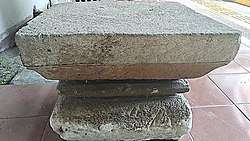Sitopayan I inscription
Sitopayan I inscription is an inscription written in a mixed of Old Malay and Old Batak languages,[1] written mostly using Old Javanese characters with some words using Old Batak characters.[1] The inscription was found at the Biaro (temple) Si Topayan, in Sitopayan village, Portibi District, North Padang Lawas Regency, North Sumatra Province, Indonesia.[1][2] The inscription is quite short, it is written on one of the horizontal sides of a base of a stone idol.[2] F.D.K. Bosch thought that this inscription was made in the 13th century CE, based on the shape and characteristics of the script.[2]

The inscription mentioned three people named Hang Tahi, Si Rangit, and Kabayin Pu Anyawari who made an idol house.[2] The use of two languages, namely Old Malay and Old Batak, raises the notion that the community around the area was bilingual.[1] In addition, the mentioning of three articles Hang, Si, and Pu (Mpu) in the people names (Tahi, Ranggit, and Kabayin Anyawari) also reflects the characteristic habit of a Malay speaking people.[1]
Currently, the inscription is stored in the North Sumatra State Museum, with the inventory number 1517.1.[2]
Text
This inscription text according to Bosch (1930) is as follows:[2]
- tat kāla hang tahi si Ranggit
- kaba(ga)yin pwanyawāri babwat bagas
- brahala sātap
Translation
The translation of this inscription is as follows:[2]
- at that time hang tahi, si ranggit (and)
- kabayin pu anyawari makes a
- home for the gods under one roof
See also
- Bahal temple, related temple in the same area
- Sitopayan II inscription
References
- Nasoichah, Churmatin (2018-01-05). "Prasasti Sitopayan 1 & 2: Tinjauan Aspek Ekstrinsik dan Intrinsik". Berkala Arkeologi Sangkhakala (in Indonesian). 15 (1): 11–29. ISSN 2580-8907.
- Susetyo, Sukawati (2010). Kepurbakalaan Padang Lawas, Sumatera Utara: Tinjuauan Gaya Seni Bangun, Seni Arca Dan Latar Keagamaan (PDF) (in Indonesian). Depok: Fakultas Ilmu Pengetahuan Budaya, Program Studi Arkeologi, Universitas Indonesia. pp. 208–209.